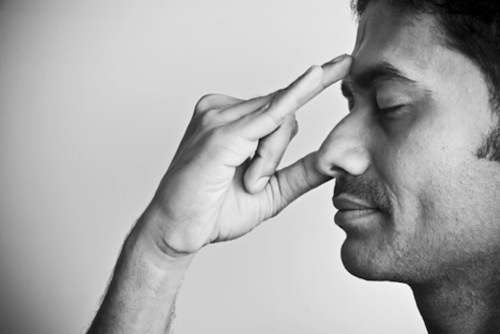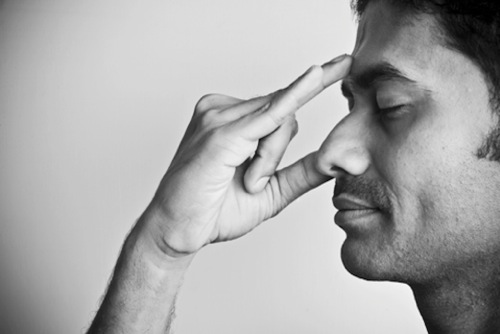
04 May Top 3 Breathing Exercises for Calming and Healing

Breath is the fundamental source of our body’s energy, according to the Pranayama practice of Yoga and Ayurveda. We breathe involuntarily, often unconsciously, but the process of controlling our breath also helps us control our vital energy or life force. Far more than simply feeding our cells with oxygen and keeping us alive, Pranayama (prana meaning vital force, ayama meaning control) can energize, heal and de-stress, mentally as well as physically.
“Breathing includes inhalation and exhalation but pranayama includes retention of breath known as ‘Kumbhaka’ in Sanskrit as well,” explains Flex instructor Micha Chan, who conducts some of his classes in Cantonese to help break the language barrier for Hongkongers. “This is a very important process. The ancient texts, including Hatha Yoga Pradipika, say that retention of air increases the level of prana and regulate the flow of prana throughout the body. So pranayama can help remove ailments and also even prevent the aging process.”
He also emphasizes the importance breath has on the mind. “The mind, consisting of thoughts and emotions, is closely related to the breath. When the mind is calm and relaxed, breathing is smooth and slow via the diaphragm. If you are stressed, breathing is fast and shallow via the chest. In this way, the mental and emotional states affect breathing, and vice versa, breathing can affect your mental state.”
Here three of Flex’s instructors talk us through their favorite pranayama practice and their benefits.
Bhramari Pranayama, Humming Bee Breath
Recommended by Michelle Ricaille
“Bhramari Pranayama is a simple yet powerful breathing/meditation practice which anyone can do,” says Michelle. “Some pranayama practices can be dangerous for certain health conditions and should only be taught by a competent teacher.”
Technique
Sit in a comfortable crossed-leg position, close your eyes and relax your body. The mouth should remain closed for the entire practice.
Inhale through both nostrils for 5 counts and exhale slowly through both nostrils while making a humming bee sound with the back of your throat. The humming sound should be mellow, smooth and continuous for the duration of the exhalation.
This is one round repeat 9 more times, making a total of 10 rounds for beginners. The goal is to work up to 10-15 minutes. The longer you practice this pranayama the greater the benefits.
Benefits
Bhramari Pranayama has been scientifically shown to reduce cerebral tension, which helps to alleviate headaches, anxiety, insomnia and stress, some of the most common symptoms in people who live in big cities. Bhramari has also been shown to increase the healing capacity of the body by increasing the vibrational energy with in the cells through the sound that is created on the exhalation.
Contra-indications
Don’t practice while lying down or if you have an ear infection.
Sitkari, Cooling Breath
Recommended by Micha Chan
Technique
Gently open your mouth, keeping the upper and lower teeth touching each other and inhale through mouth with a hissing sound. Then performing kumbhaka (breath retention) with bandhas (energy locks) and exhale through the nostrils.
Benefits
The air passing over the tongue lowers the temperature of the blood removing excess heat in the body and helping with issues like acidity and hypertension. This Pranayama harmonizes the secretions of the reproductive organs and the endocrine system, improves the digestion, lowers high blood pressure and purifies the blood. It also helps to calm the mind and emotions.
Contra-indications
It’s good to practice in hot summer as it’s cooling but avoid practicing this sitkari pranayama in cold weather, and if you are suffering from cough, cold, asthma or respiratory issues.
Nadi Shodhana, Alternate Nostril Breathing
Recommended by Jessica Williams
Technique
Sit comfortably and close your eyes. Place the index and middle fingers of the right hand between the eyebrows so that the ring and little fingers rest on the left nostril and the thumb on the right. Start by closing the right nostril with the thumb and exhaling through the left nostril. Breath in through the left nostril, pressing it closed before opening the right nostril and breathing out. Repeat with long, deep smooth breaths.
Benefits
One of my favorite pranayama exercises, I recommend Nadi Shodhana because it’s great for managing stress and helping to balance fluctuating energy levels. So much of the work I do, both through teaching yoga and nutritional counseling, is about helping people reduce stress and overcome the many, many symptoms that result from chronic stress.
Science knows that we cycle our breathing throughout the day, with one nostril being dominant at a time. The cycle is regulated by the same part of the brain that helps manage our stress response. Short-term benefits is that we feel calm and grounded and long term it helps manage the affects of elevated cortisol levels, helping us to shift from our sympathetic nervous system (fight or flight response) to our parasympathetic system (rest and digest system).
Micha Chan, Michelle Ricaille and Jessica Williams all teach regular yoga classes at Flex Central and One Island South. Find out when their next sessions will be here.
Plus, don’t miss Micha’s 250-hour teacher training course in September. He will be teaching ancient yoga wisdom using traditional techniques, in Cantonese with some English.


